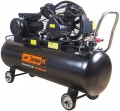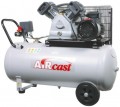Input performance
The amount of air that the compressor is able to process per unit of time; usually stated in liters per minute. Performance, along with pressure (see below), is one of the most important parameters: it is it that primarily determines how compatible the compressor will be with one or another pneumatic tool.
It is worth choosing a model according to this indicator in such a way that it can be guaranteed to “pull out” all the tools that can be connected at the same time. Air consumption is usually directly indicated in the characteristics of each tool, and it is quite simple to calculate the total requirement. However, due to the design features, the compressor must have a certain performance margin; the specific value of this stock depends on a number of nuances.
The main point is that some companies indicate for their units the performance at the outlet (how much air is supplied to the tool), while others indicate at the inlet (how much air the compressor sucks in). Since no compressor is perfect, part of the air is inevitably lost during the compression process, so the amount of air at the outlet will always be less than at the inlet. Accordingly, if the output performance is indicated in the characteristics, a margin of 10-20% is recommended, and if the input is 35-40%.
There are also more complex techniques that allow you to more accurately derive the required performance depending on the characteristics of specific tools; they can be found in...special sources.
Rated pressure
The maximum pressure created by the compressor during operation. This parameter, as well as the performance described above, is very important for selecting a compressor for a specific pneumatic tool: it is necessary that the nominal pressure be not lower than the working pressure of the tool. At the same time, high pressure is not a problem — it can be reduced by the appropriate regulator on the gearbox.
Most modern compressors have a
pressure rating of 8 bar, which is sufficient for most air tools. Units for 6 bar belong to the entry level, their main purpose is painting work, where high pressure is not required. There are also options for 10 bar and even more — they, usually, belong to specialized models and cost accordingly. Therefore, it is worth looking specifically for a high-pressure unit only if this parameter is critical for the planned work (for example, if you need a compressor for tyre fitting).
When selecting according to the nominal pressure, it must be taken into account that the maximum allowable pressure in the receiver is usually indicated as the nominal pressure. The pressure actually given out by the compressor to the outlet is often somewhat less, this is due to some design features. For the most popular nominal pressure options — 8 and 10 bar — the real figures are usually 2 bar less, i.e. 6 and 8 bar respectively.
Noise level (LPA)
The sound pressure level in decibels at a certain distance between the noise source and the ear of the compressor equipment operator. Since people do not work in the immediate vicinity of the compressor, the parameter will be useful for estimating the noise level at a distance. It is most often measured at a distance of 7 m from a working installation, less often at a distance of 1 m.

